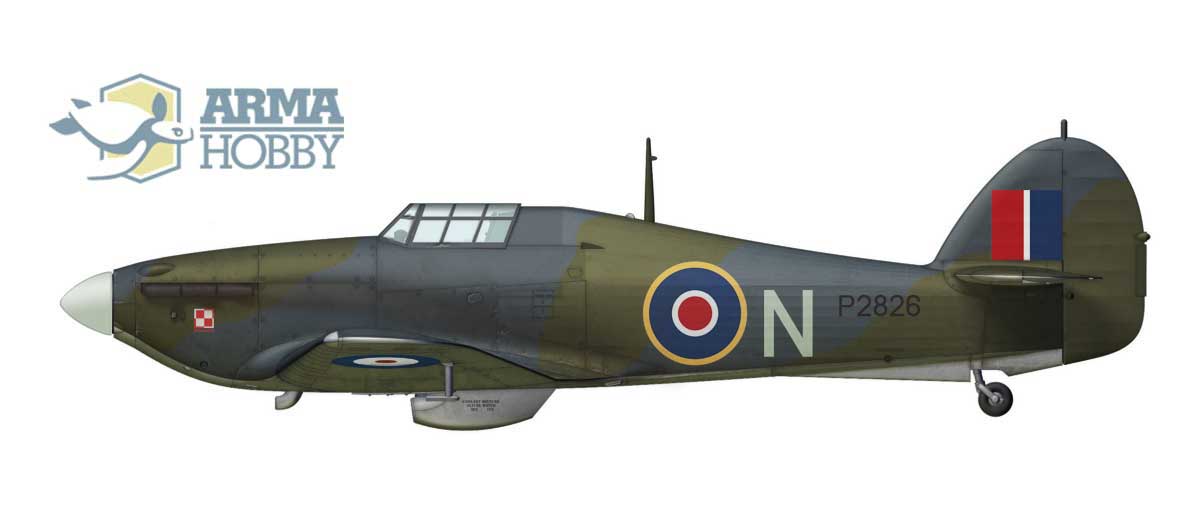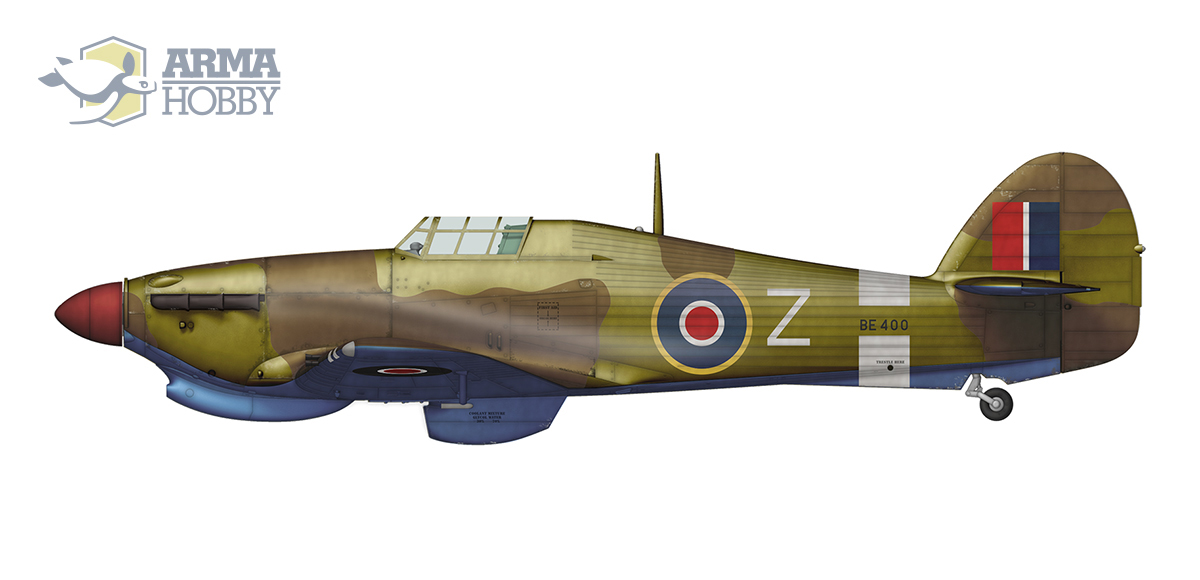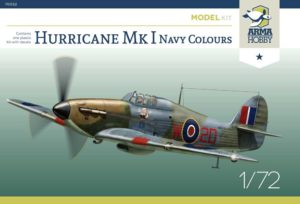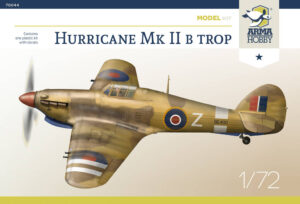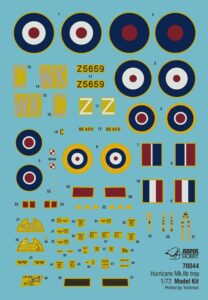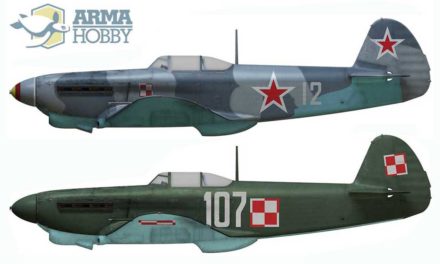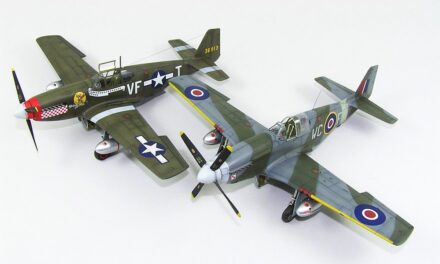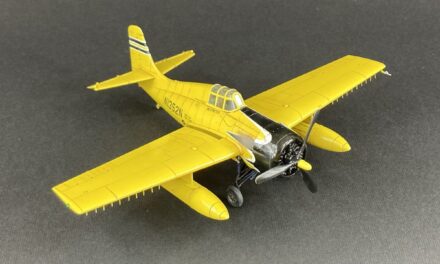No. 318 “City of Gdańsk” Polish Fighter-Reconnaissance Squadron was formed on 20 March 1943 at RAF Detling, England, as the final unit of the Polish Air Forces in Great Britain. Initially, it received fourteen worn out Hawker Hurricane Mk.Is, six of which were Sea Hurricanes that had previously been used on CAM ships (catapult aircraft merchant ships). The squadron was also provided with one Hawker Hurricane Mk.X. Since the Hurricane Mk.I had already been withdrawn from active service, there was a serious problem with obtaining spare parts, made all the more difficult by the bad technical condition of the aircraft – even though they had been received directly from Maintenance Units, where they had undergone general overhauls.
Cover artwork by Marcin Górecki.
Having in mind the purpose for which the squadron had been established, its mechanics developed a project for converting the aeroplanes into reconnaissance aircraft. But the equipment issues resolved themselves on their own, for the period of training in Great Britain did not last long. Towards the end of July, the squadron returned its aircraft and began to ready itself for the planned move to the Middle East.
Hawker Sea Hurricane Mk Ia, P2826/N, 318 Polish Squadron, Detling 1943. After service with the MSFU on CAM Ship`s, the aeroplane was transferred to this new Polish Squadron for training purposes. Aeroplane remains in Temperate Sea Scheme camouflage. Photo from Wojtek Matusiak collection.
In mid-August 1943, after the completion of medical examinations, which were required in order to qualify its pilots for service in the new theatre of operations, the unit was sent on its way, arriving in Egypt on 29 August. A few days later, it was transferred to Muquebila in Palestine. While there, on 14 September, the squadron took possession of nine Hawker Hurricane Mk.IIbs. More fighters were received on 15 September (six) and 17 September (three). Just as had been the case with the Hurricane Mk.Is in Great Britain, the mechanics had their hands full of work in order to make the aircraft combat ready for operation in the fighter-reconnaissance role.
Hawker Sea Hurricane Mk Ia, P2826/N, 318 Squadron PAF, Detling 1943. Artwork by Zbyszek Malicki.
The squadron commenced a period of intensive training in photo and visual reconnaissance, however the climate was extremely difficult and many of its pilots soon fell ill with malaria. Finally, in the beginning of November 1943, the unit was transferred to Qassasin in Egypt, where it remained until April 1944. While there, it was re-equipped with Spitfire Mk.Vs, and later sent to Italy, where it served until the end of the war conducting reconnaissance flights for the Eighth Army.
The Hurricane Mk.IIb Trop in Polish Service in the Middle East
Arma Hobby has made a Model Kit edition of the Hawker Hurricane Mk.IIb Trop.
Two paint schemes have been included, one of which depicts the aircraft in the colours of No. 318 “City of Gdańsk” Fighter-Reconnaissance Squadron of the Polish Air Forces. Specifically, this is a replica of airframe serial number BE400, which was manufactured at the Hawker plant. Like all other Hurricanes operated by the squadron, it was given a single individual letter – Z. The marking was characteristic for the unit, and was later carried over to its Supermarine Spitfire Mk.Vs.
Hurricane Mk.IIb trop BE400/Z, 318 Squadron PAF, LG Wilhelma, Palestyna, “Virile” exercise, October 1943. Photo from Wojtek Matusiak collection.
The aircraft is shown as it looked during the “Verile” exercises in October 1943, during which the squadron took part in a simulated an invasion of Palestine by the Polish II Corps, and the “Tussle” manoeuvres of January 1944, which were held in Egypt. The primary objective of the former consisted in verifying the readiness of II Corps for front line operations. Training commenced on 21 October. The fighters took off first from Wilhelm, and then Muquebila airfield. The exercises ended on 29 October.
 “Tussle” got under way on 17 January 1944. The squadron formed part of the “Kahritian” forces (or “Karritian” – the entry in the unit’s ORB (Operations Record Book) is somewhat illegible), which fought against the “Alexandrians”. During the exercises, No. 318 Squadron RAF carried out reconnaissance missions for the land component. After the manoeuvres, the pilots continued training, while the unit was gradually refitted with Spitfire Mk.Vs.
“Tussle” got under way on 17 January 1944. The squadron formed part of the “Kahritian” forces (or “Karritian” – the entry in the unit’s ORB (Operations Record Book) is somewhat illegible), which fought against the “Alexandrians”. During the exercises, No. 318 Squadron RAF carried out reconnaissance missions for the land component. After the manoeuvres, the pilots continued training, while the unit was gradually refitted with Spitfire Mk.Vs.
Interestingly, for “Tussle” the fighters received special temporary markings. The first were two white stripes painted on the upper left wing surface (from the leading edge to the aileron and from the leading edge to the cockade on the underside). The other was a light-coloured stripe on the tail (in exactly the same place where aircraft painted in the Day Fighter Scheme had a Sky-coloured stripe). As can be seen in photographs from the era, the stripe was broken for the serial number.
Photo: Hurricane BN270/K with white stripe on fuselage. Photo from Wojtek Matusiak collection.
An analysis of pictures available in the literature shows that those fighters which had stripes on their wings retained the dark propeller spinner (most probably red, which was typical for RAF aircraft in the Mediterranean theatre). Whereas aeroplanes with a stripe on the fuselage had light-coloured spinners (in all likelihood white).
Hurricane Mk.IIb trop BE400/Z, 318 Squadron PAF, LG Wilhelma, Palestyna, “Virile” exercise, October 1943. Artwork by Zbyszek Malicki.
It is difficult to determine unequivocally whether the paint used for these markings was removable, however the photograph of Hawker Hurricane Z5261/M(ay), which shows the stripe painted over, may indicate that it was standard. Unfortunately, data is sparse and we cannot state indisputably whether both types of markings were applied for the “Virile” and “Tussle” exercises.
It is therefore up to you, the modeller, to decide which markings should be used. Nevertheless, I would recommend that you refer to the following two books: “Polish Fighter Colours”, Part 1, and “Polski Samolot i Barwa”.
Hurricane IIb trop serial unknown/”L”. Temporary white stripes insignia is vivible on the left wing. Wojtek Matusiak collection.
The aircraft is shown as it looked during the “Verile” exercises in October 1943, during which the squadron took part in a simulated an invasion of Palestine by the Polish II Corps, and the “Tussle” manoeuvres of January 1944, which were held in Egypt.
The primary objective of the former consisted in verifying the readiness of II Corps for front line operations. Training commenced on 21 October. The fighters took off first from Wilhelm, and then Muquebila airfield. The exercises ended on 29 October.
 “Tussle” got under way on 17 January 1944. The squadron formed part of the “Kahritian” forces (or “Karritian” – the entry in the unit’s ORB (Operations Record Book) is somewhat illegible), which fought against the “Alexandrians”. During the exercises, No. 318 Squadron RAF carried out reconnaissance missions for the land component. After the manoeuvres, the pilots continued training, while the unit was gradually refitted with Spitfire Mk.Vs.
“Tussle” got under way on 17 January 1944. The squadron formed part of the “Kahritian” forces (or “Karritian” – the entry in the unit’s ORB (Operations Record Book) is somewhat illegible), which fought against the “Alexandrians”. During the exercises, No. 318 Squadron RAF carried out reconnaissance missions for the land component. After the manoeuvres, the pilots continued training, while the unit was gradually refitted with Spitfire Mk.Vs.
Interestingly, for “Tussle” the fighters received special temporary markings. The first were two white stripes painted on the upper left wing surface (from the leading edge to the aileron and from the leading edge to the cockade on the underside).
Photo: Hurricane BN270/K with temporary markings of white stripe on the fuselage. Photo from Wojtek Matusiak collection.
Such temporary markings were by no means unique in the Royal Air Force, as the British employed them regularly during manoeuvres. For example, during the “Spartan” exercises (March 1943) aircraft of one of the combatants received a temporary paint scheme in the form of white stripes running from the propeller to the cockpit, while the spinners and left wing undersurface were painted black. Whereas in September 1943, during Operation Starkey (a sham invasion of France), Allied aeroplanes were painted with black and white stripes around the wing edges.
See also:
- Sea Hurricane Mk Ia kit with 318 Squadron markings (Detling, UK) link
- Hurricane Mk IIb trop kit with 318 Squadron Mid-East markings link
- Other Hurricane model kits in Arma Hobby online shop!
An enthusiast of air war during the Battle of Britain, over North Africa and Italy, over South East Asia and France in 1940. In free time builds models in 1/72 scale, and from time to time in 1/48 scale.
This post is also available in:
 polski
polski




